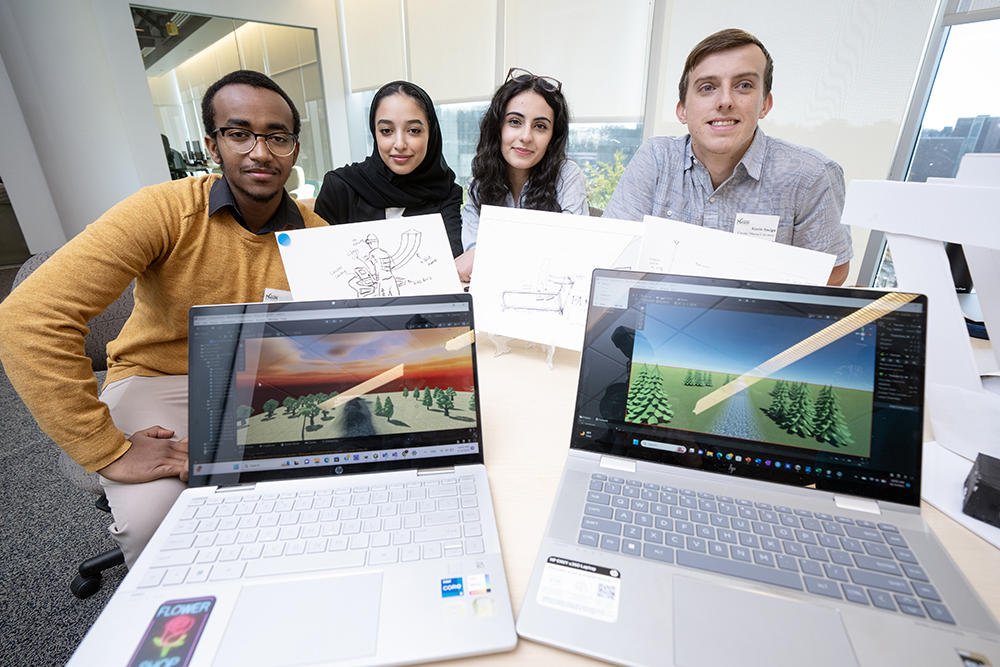As a capstone to the bioengineering program at George Mason University, senior students complete a team-based, two-semester design project developing solutions to real-world biomedical and/or clinical problems.
At the topping off ceremony for Fuse at Mason Square, Rebecca Schuetz, Gavin Smiga, Lana Hashem, Kirubel Tadesse, and Rasil Alamri presented their group’s project on a virtual reality-based physical rehabilitation system.
Tell us about your project.
Many people around the world need lower limb rehabilitation to regain function, including more than 101 million stroke patients and many athletic injury patients. Despite the vast number of people needing rehabilitation, only 36% of these patients complete their plans of care and achieve maximum results. Virtual reality has proven to be more effective at improving gait and balance in stroke and rehabilitation patients when compared to traditional therapy. VR also is considered to be more exciting and engaging for patients. While some virtual reality rehabilitation tools currently exist, they are often inaccessible due to size, cost, and complexity. Therefore, our goal is to create a portable, inexpensive, and engaging virtual reality lower-limb rehabilitation platform that can be set up in a range of locations and used by patients in their own homes to regain mobility, muscular strength, and balance.
What inspired you to select this topic?
As a team, we talked about our interests, strengths and weaknesses, and passions, and settled on this project. We all had a strong background in coding, and we loved the idea of using code and virtual reality in a way that would improve patient outcomes. Through our interviews with rehabilitation patients and physical therapists, we were inspired by the need to make rehabilitation more engaging.
What has been your greatest success thus far?
Our greatest success so far has been leveraging clinical information to engineer critical aspects of our virtual reality rehabilitation platform. Through interviews with a diverse group, including physical therapists and patients undergoing physical therapy for lower limb rehabilitation, we gathered invaluable insights. The information encompasses aspects such as initial patient assessments, patient monitoring metrics, exercise efficacy, range of motion requirements, patient engagement strategies, and challenges faced in physical therapy. Armed with this comprehensive data, we enhanced the design of virtual environments and refined the overall design, marking a pivotal success in our project.
What is one thing you’ve learned while working on this project that will be useful to you in the field?
One significant takeaway from working on this project is the importance of brainstorming and prototyping. We started with five different designs and continued to test to narrow down our options to one design that met all our requirements. In addition, we valued feedback from experts who have used this technology as it helps us understand the strengths and weaknesses that we should address in our project. This will be very useful in the bioengineering field since it requires lots of testing and prototyping to ensure that our product meets the specific user needs of our stakeholders.
How would dedicated research space, such as the plans for Fuse at Mason Square, help sustain your project?
Finding a space large enough to base our project and one that was secure and quiet enough to allow for an optimal development environment was one of our great challenges. We have repurposed a room that was intended for storage space. A dedicated research space would equip us with all the tools we truly need to have a successful final design, as well as a testing space. With Fuse at Mason Square in particular, the fact that it has been purpose-built for research and will provide a space for all departments to come together is very exciting. For instance, once we have developed our device, we could collaborate with kinesiology or Psychology Department researchers to conduct studies where we test the viability of our product and improve it further. Then, we could collaborate with the Costello College of Business on the possibility of bringing our product to market.

Related News
- October 14, 2025
- September 19, 2025
- August 6, 2025
- December 9, 2024
- December 4, 2024
